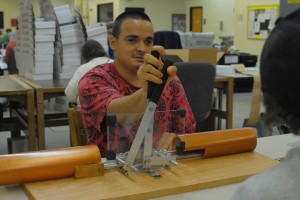Designers: Max Li, Chad Liu, Peter Zhu
Client Coordinator: John Wiltshire
Supervising Professors: Kevin Caves and Richard Goldberg
INTRODUCTION
OE Enterprises is a non-profit, community rehab program that provides services and employment for people of various disabilities. OE receives contractual work, which they break up into a wide range of tasks that their clients perform. OE pays their employee on a per unit output basis. Our client is an employee at OE, a 32-year-old male whom we will call Fitch, and he has limited use of his left hand and low dexterity in his right. Fitch also has cognitive disabilities that make it difficult for him to understand or remember instructions. OE asked us to develop devices that aid our client and other employees in several of their tasks, which involve the assembly of small widgets. These tasks require good hand-eye coordination, dexterity and strength and are difficult, if not impossible, to be done with one hand. The tasks are:
Bolt and sleeve: Foot-long bolts must be fitted with electrical heat shrink sleeves. Fitch currently stabilizes the bolt against his abdomen with his left hand, aligns the sleeve with the tip of the bolt and then pushes against himself as he slides the sleeve down the bolt. His method is slow and potentially harmful.
Component Board: Two metal brackets require significant force to be inserted into a gray, plastic base, the component board. The current method requires one hand to hold the base while the other hammers in the bracket.
After the brackets have been inserted, screws must be fastened so that the brackets maintain a set distance apart.
Electronic Interlocker: Copper contacts must be firmly wedged in slots in the clear plastic interlocker base. Employees use two thumbs and forcefully pushing the pieces into place. The process is slow and painful.
More adept employees are currently assigned to these complex tasks and thus our client is excluded.
STATEMENT OF IMPACT
In testing all four of our devices, our client showed visible enjoyment. He was clearly ecstatic that he could now perform the same tasks as many of his coworkers. Our client’s efficiency was dramatically increased with the aid these devices. At the conclusion of our trial runs, our client was reluctant to stop and even motioned for more parts to assemble. In commenting on these devices, Tracey, an OE Enterprises staff member said, “I’m impressed by how simple the design is. This is better than what [the client] was doing before, since now he has no chance of hurting himself.”
TECHNICAL DESCRIPTION
Bolt Pole-Vault (bolt and sleeve task, figure 1a): To allow one-handed assembly of the bolt, we built a ramp that holds the bolt at an elevated angle from the table. The ramp is made from two thin pieces of oak, braced together by a 90-degree bracket to form a long V that is also short enough to allow top part of the bolt to protrude out. Fitch uses his right hand to place the bolt onto the ramp and then aligns and slides a sleeve down while slightly lifting the upper end of the bolt. A block of wood at one end of the base acts as the stopper. A non-skid mat glued to the bottom of the base prevents sliding of the device.
The Eagle Opportunity (component board task, figures 1b and 2): To address inserting brackets with one hand, we built a large-scale squeeze clamp from two sliders. We produced a small platform for the component board to be docked. On either side of the platform are two sliders that hold a small protruding edge lined up precisely with the gaps in the component board. We fashioned a squeeze handle from a series of aluminum beams dipped in Plasti-Dip and attached it to both sliders. PVC pipes and plastic sheets cover dangerous parts of the device. To use this device, Fitch docks the component board on the platform and lightly places the two brackets in both gaps, one at a time. He then squeezes the handle, causing the two sliders to come together and their protruding edges to push the brackets into the component board.
To allow our client to fasten screws with one hand, we built an oak platform with two small screwdrivers attached at a preset distance apart. Our client places the component board, with brackets inserted, into the platform and pushes both brackets in as far as they will go. He then turns the screwdrivers to fasten the screws and tighten the brackets.
The George Foreman (electronic interlocker task, figure 1c): We designed a clamp-like device that is constructed for securing copper contacts into wedges painlessly. Using oak wood and hard polymer plastic, we built an “alligator mouth” that closes to apply uniform force across the contacts. For Fitch to complete the task, he places the interlocker base into the designated area fenced by four short walls and places the individual contacts on top of the grooves. Grasping the large handle, he pushes down the upper surface thereby wedging all the contacts in place.
The total cost of these devices is $220.

